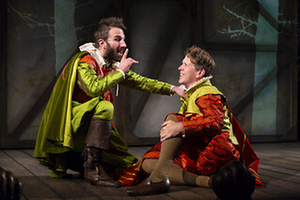Review: ROSENCRANTZ AND GUILDENSTERN ARE DEAD at Huntington Theatre Company

Tom Stoppard's Rosencrantz and Guildenstern are Dead is alive and well at the Huntington Theatre-resuscitated beyond the didactic philosophy with which the text is too often approached in academic settings and fully breathing as the comedic bacchanalia of narcissism and self-introspection that Stoppard engineered. The play obsessively examines the tribulations of two ill-fated, minor characters from William Shakespeare's Hamlet, taking the audience on a stroll through the minds of fictional men who seem to realize, not only that they exist within a play, but that they merely exist within that play so that something bad may happen to them. The audience joins the two as they pass the time, waiting for whatever is coming... to come.
Alex Hurt and Jeremy Webb anchor the production expertly as Rosencrantz and Guildenstern respectively (though the specifics of who plays which role confuse the characters in the piece regularly, including Rosencrantz and Guildenstern themselves). Hurt brings to light the idiosyncrasies of reality which are so rarely mirrored on stage, itching himself and nervously biting has nails as impulses to appease the naive, boyish, doe-eyed Rosencrantz. His journey over the course of a few hours feels like a cross-section into the process of maturing, his original bluntness being replaced with a learned nonchalance. Webb's Guildenstern handles himself with a bravura and Gielgud-esque machismo that seems to diminish as he becomes anxious about his impending future. At top of show, the two seem to engage as delightful anachronisms to each other, as though Kenneth Branagh (Webb) were forced to aid in one of Bill and Ted's (Hurt) cinematic adventures. Stylistically off-kilter from the top, Hurt's too-realness is all but devoured by Webb's silly fake-ness, and the rest of their time together is spent chipping away at the other until, in the final moments, the audience sees two men stripped of all charade and left raw and uncertain even as they step into their final decisions.
Fleshing out the cast are two separate ensembles; a troupe of roving Tragedians without limit to what they will do for the right price, and a smattering of familiar figures from Hamlet, who gasp, weep, and shriek in performances that would turn Stella Adler in her grave. Both groups consistently roll the audience in the aisles and both boast a respectable smorgasbord of local Boston and Providence artists (a shining reminder that, at times, even our largest theatres need not look far for talent and need not break the bank on scores of New York imports). Highlights among these crowds include Laura Latreille as an actor rarely seen without her faux horse and Matthew Bretschneider as Alfred, the unwilling twink who plays all of the women's roles required by the troupe. Latreille is cavalierly preposterous and multifaceted in her clowning. Bretschneider is able to overcome the inevitable laughter that spews from Boston's blue-haired crowds when a man wears a dress and becomes feverishly violent and self-autonomous, landing laughs on the merits of his physical comedy rather than his costume. One of the best scenes in the show features the Tragedians rehearsing the play Hamlet has requested of them. In this sequence, not only are the ensemble's comedic skills put to the test (they pass with flying colors) but the entire piece is underscored in sight of the audience with chimes, guitars, and percussion in a way that would have Hanna-Barbera foley artists scrambling for their notes. (Bravo to music consultant Matthew Stern!)
Wilson Chin's deceptively simple scenic design successfully melts between different locales, but, in Acts I and II, is muddied and obscured in unnecessary ways by the jarringly literal projections designed by Zachary G. Borovay. Act III is a refreshingly simple sight as a seemingly endless void of blackness is interrupted by a full moon and the minimal signifiers of a ship, rather than the criss-cross of intersecting projections that plague the beginning two-thirds of the piece. Chin's sets alongside Ilona Somogyi's costumes fortuitously provoke an awareness of meta-theatricality that pervades the duration of the evening.
The script itself, though considered a canonized English work and undoubtedly well-crafted, suffers from the same ailments as many works by Ionesco, Pinter, and Genet with which it is frequently grouped. There are pockets of excess fat that not even the most direct team can smooth over. Though not a phenomenally lengthy piece, the pacing (at no fault of this production itself) ebbs and flows. To the credit of director, Peter DuBois, and the cast, when this production flows, it really flows. But in the moments of ebb, the unrest in the audience is palpable. Perhaps this is an inevitable outcome for anyone pretentious enough to write a plot that centers around waiting for something to happen. At no point does the piece become boring, but the hermetic musings on the human condition feel diluted down to a limited impact by nebulous sequences of emptiness. However, this criticism falls less on this production or even on Stoppard's work and more points to a personal frustration with the American theatre's current fearful adherence to playwrights and their estates' legal teams.
Overall, the production is a delight which is able to rekindle in its audiences a belief in the power of old-fashioned theatre magic.
Reader Reviews

Videos
